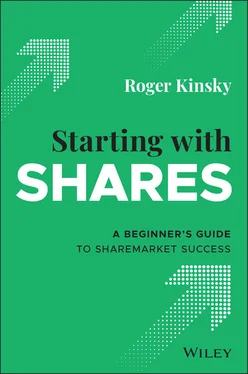1 Cover
2 Title Page Starting with SHARES A BEGINNER'S GUIDE TO SHAREMARKET SUCCESS Roger Kinsky
3 Copyright First published in 2022 by John Wiley & Sons Australia, Ltd 42 McDougall St, Milton Qld 4064 Office also in Melbourne Typeset in Liberation Serif 11pt/14pt © John Wiley & Sons Australia, Ltd 2022 The moral rights of the author have been asserted ISBN: 978‐0‐730‐39516‐4 All rights reserved. Except as permitted under the Australian Copyright Act 1968 (for example, a fair dealing for the purposes of study, research, criticism or review), no part of this book may be reproduced, stored in a retrieval system, communicated or transmitted in any form or by any means without prior written permission. All inquiries should be made to the publisher at the address above. Cover design by Wiley Cover Image: © Miloje/Shutterstock Illustration sketches and concepts by Roger Kinsky Illustrations by Delia Sala/Wiley Disclaimer The material in this publication is of the nature of general comment only, and does not represent professional advice. It is not intended to provide specific guidance for particular circumstances and it should not be relied on as the basis for any decision to take action or not take action on any matter which it covers. Readers should obtain professional advice where appropriate, before making any such decision. To the maximum extent permitted by law, the author and publisher disclaim all responsibility and liability to any person, arising directly or indirectly from any person taking or not taking action based on the information in this publication.
4 Introduction
5 Chapter 1: What you need to know Meet Michelle Trust yourself Knowledge level you'll need Markets are unpredictable Risk and reward are related Shareholders are owners of a business
6 Chapter 2: Getting into shares What are shares? Making shares available for trading Becoming a shareholder Shares you can't buy Why share prices change
7 Chapter 3: Profiting from shares Making profit from capital gains Profiting from dividend income Comparing capital gains and dividends
8 Chapter 4: Is share investing gambling? Similarities between share investing and gambling Differences between share investing and gambling
9 Chapter 5: Benefits and pitfalls of share investing Are shares a good investment? Investing rules
10 Chapter 6: Sectors and shares for your portfolio Understanding two key terms Considering sectors Share selection using a market index Sectors and shares you may want to consider
11 Chapter 7: Setting up to trade Reasons for wanting to trade shares Deciding between offline and online trading Finding a broker Understanding CHESS
12 Chapter 8: Getting to know your shares Using fundamental analysis Obtaining the info you need
13 Chapter 9: Getting your timing right Using charting to guide your trading decisions Identifying trends Trend trading
14 Chapter 10: Buying and selling shares Getting down to the nuts and bolts of trading Types of order Market and share price movements Developing your trading plan Placing orders
15 Chapter 11: Managing your shares Four key activities Trading frequency Compiling and maintaining records
16 Chapter 12: Turbocharging your share investment The power of compounding Varied portfolio Averaging Momentum Applying principles (rules) to boost returns Good money management
17 Chapter 13: Let's recap Important points to remember Profiting from shares Using fundamental analysis Charting to time your trades Trading Managing psychological factors Managing your portfolio
18 Go for it!
19 Appendix: Details of my portfolio spreadsheet
20 Index
21 End User License Agreement
1 Chapter 3Table 3.1: Grossing‐up factors for dividends with different franking levels...
2 Chapter 6Table 6.1: The main Australian market indicesTable 6.2: Makeup of the XTL, July 2021
3 Chapter 9Table 9.1: Suggested combinations of time periods, time intervals, type and purp...Table 9.2: Sensitivity, smoothing and application for different moving average t...
4 Chapter 10Table 10.1: The combination of market and share price movements on buying and se...
5 Chapter 12Table 12.1: Compound growth at 3% and 7% paTable 12.2: Effect of the DRP on number of shares owned after 10 yearsTable 12.3: Total return on shares over the long term.Table 12.4: Returns after one year from following a buy and hold strategyTable 12.5: Returns after one year from limited losses and letting profits run....
1 Chapter 1Figure 1.1: Increasing your possible reward usually means increased risk
2 Chapter 2Figure 2.1: Possible price changes in one day's trading
3 Chapter 3Figure 3.1: Brokerage is usually the only selling expense for sharesFigure 3.2: Selling shares for less than you paid for them, results in a los...Figure 3.3: The share price usually falls on the ex‐dividend dateFigure 3.4: The time delay between the ex‐dividend date and the payment date...
4 Chapter 5Figure 5.1: Fall and rise of the All Ordinaries index in 2020
5 Chapter 6Figure 6.1: Industry sectors divide the market according to business type
6 Chapter 8Figure 8.1: Total revenue minus expenses equals profitFigure 8.2: Choosing a share with a higher or lower PE than the market avera...Figure 8.3: Uncertainty increases as profit forecasts get further into the f...
7 Chapter 9Figure 9.1: An example line chartFigure 9.2: An example OHLC chartFigure 9.3: An example candle chartFigure 9.4: Different price scenarios produce different candlesFigure 9.5: Comparing relative price performance using a percent chartFigure 9.6: The three basic trends: sidetrend, uptrend and downtrendFigure 9.7: Combined trends form a longer term uptrend (dashed line)Figure 9.8: ‘Eye method’ of spotting a trendFigure 9.9: Spotting trend variations in OHLC or candle chartsFigure 9.10: Difference between short‐ and long‐term moving averages...Figure 9.11: Using a moving average to identify buy and sell regionsFigure 9.12: Using moving average crossover signals to identify buy and sell...
8 Chapter 10Figure 10.1: Spread is the difference between the highest bid and lowest off...Figure 10.2: Sudden price drops can cause stop loss orders to be ineffectiveFigure 10.3: The market is falling but the share price is risingFigure 10.4: An example intra‐day chart
9 Chapter 11Figure 11.1: The optimum level of trading
10 Chapter 12Figure 12.1: The power of compound growthFigure 12.2: Growth of $10 000 investment at different rates of return....Figure 12.3: Overshoot due to momentumFigure 12.4: Apparent recovery in a downtrend before it continues
1 Cover Page
2 Table of Contents
3 Title Page Starting with SHARES A BEGINNER'S GUIDE TO SHAREMARKET SUCCESS Roger Kinsky
4 Copyright First published in 2022 by John Wiley & Sons Australia, Ltd 42 McDougall St, Milton Qld 4064 Office also in Melbourne Typeset in Liberation Serif 11pt/14pt © John Wiley & Sons Australia, Ltd 2022 The moral rights of the author have been asserted ISBN: 978‐0‐730‐39516‐4 All rights reserved. Except as permitted under the Australian Copyright Act 1968 (for example, a fair dealing for the purposes of study, research, criticism or review), no part of this book may be reproduced, stored in a retrieval system, communicated or transmitted in any form or by any means without prior written permission. All inquiries should be made to the publisher at the address above. Cover design by Wiley Cover Image: © Miloje/Shutterstock Illustration sketches and concepts by Roger Kinsky Illustrations by Delia Sala/Wiley Disclaimer The material in this publication is of the nature of general comment only, and does not represent professional advice. It is not intended to provide specific guidance for particular circumstances and it should not be relied on as the basis for any decision to take action or not take action on any matter which it covers. Readers should obtain professional advice where appropriate, before making any such decision. To the maximum extent permitted by law, the author and publisher disclaim all responsibility and liability to any person, arising directly or indirectly from any person taking or not taking action based on the information in this publication.
Читать дальше












